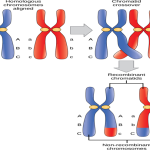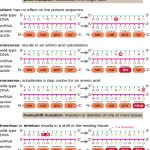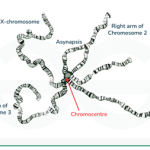Gregor Johann Mendel conducted a series of experiments on hybridization of peas. From these studies, he proposed two universally accepted laws of inheritance; the law of segregation, and the law of independent assortment. He also extensively explained dominance of characters. These two laws proposed by Mendel are the foundation of the science of genetics. Hence, as a recognition of his contribution towards genetic studies, Mendel is known as the ‘father of genetics’.
1.1. Mendel’s experiment with pea plant:
Mendel used pea plants (Pisum sativum) for his experiments as it provided many advantages such as:
- Pea varieties contain several characters with two contrasting forms which were easily distinguishable from one another.
- Flower structure of pea plant support self-pollination.
- Pea plant have short life cycle. Every year one generation if pea can be grown.
- Pea plants are relatively large in size which facilitates emasculation and pollination.
- Pea plants are relatively easy to grow and occupies only small space.
Mendel selected seven pairs of contrasting characters of the pea plant for his study. Example. Round and wrinkled seed shape. For one of his experiment, Mendel produced pure varieties of tall and dwarf pea plants by self-fertilization. Mendel cross-pollinated these two varieties of pea plant. He observed that offsprings of first generation only contained tall plants. He allowed self- pollination in the offspring of first generation. He discovered both tall and dwarf offsprings in the second generation. The tall and dwarf plants in the second generation were always in the ratio of 3:1 (3tall: 1 dwarf). He self- pollinated the dwarf plants of the second generation and observed only dwarf plants in the third generation. But when he self-pollinated the tall plants of second generation, he found that one third of them only yield tall plant in third generation, while the rest two third tall plants yield tall and dwarf plants in the ratio of 3:1. 1
On the basis of these experimental results Mendel recognized the phenomenon of dominance and proposed the law of segregation and law of independent assortment.
1.2. Law of segregation:
This law is also known as law of purity of gametes. It states that,” the hybrids or heterozygotes of F1 generation have two contrasting characters of dominant and recessive nature governed by two alleles of a gene. These alleles remain together for a long period of time but do not contaminate or mix with each other. They separate at the time of gametogenesis, so that each gamete receives only one allele of a character either dominant or recessive.”1 The law of segregation has found to occur in both plants and animals.
For example, Mendel produced pure round and wrinkled seeded pea plants by repeated self-pollination for several generations. These parents were homozygous i.e. their genotypes were RR and rr respectively. The pea plant with round seed produces the gamete with single allele R and the wrinkled one produces the gametes with single allele r. The gamete unites in the process of fertilization and produces a hybrid with round seed (Rr). In this, the allele R (round seed) is dominant over r (wrinkled seed). During gametogenesis these alleles R and r are separated along with the chromosomes to form two types of gametes. Half the gametes have the allele R and the other half have allele r. These gametes unite in three possible combinations i.e. RR, Rr, and rr to produce genetically different organism in the ratio of 1:2:1. Thus, the dominant and recessive alleles remain together for long time without contaminating or mixing with one another and segregate during gametogenesis.1

Fig 1: Monohybrid cross between yellow and green seed pea plant demonstrating law of segregation (Source: https://sciencefacts.pages.dev/law-of-segregation—definition–examples–and-diagram/)
1.3. Law of independent assortment:
This law states that “when the parents differ from one to another in two or more pairs of contrasting characters or factors then the inheritance of one pair of character is independent to that of other pair of character.”
In one of his experiments, Mendel crossed a homozygous pea plant having yellow round seeds (YYRR) with the homozygous pea plant having green wrinkled seeds (yyrr). The F1 generation hybrids were found to have yellow round seeds with genotype (YyRr). It showed the dominance of Y allele (for yellow colour) over allele y (for green colour). Similarly, Allele R (for round shape of seed) was dominant over allele r (for wrinkled seed). The four alleles Y, y, R and r can form four possible allele combination i.e. YR, Yr, yR, and yr and four type of gametes YR, Yr, yR and yr. These four types of gametes of F1 hybrid unite at random places in the process of fertilization and produce 16 types of individuals in F2 generation. The sixteen F2 individuals have the ratio of 9 yellow round, 3 yellow wrinkled, 3 green round and 1 green wrinkled. These results demonstrates that each pair of contrasting character behaves independently and bears no permanent association with one another.2 When two pairs of contrasting characters (Eg. Shape of seed and colour of seed) are considered during a cross, such kind of cross is known as dihybrid cross.

Fig 2: Dihybrid cross between homozygous pea plants having round yellow seeds and wrinkled green seeds. (Source: https://sciencefacts.pages.dev/law-of-segregation—definition–examples–and-diagram/)
1.4. Application of Mendel’s law:
- Mendel’s law helps the scientists to understand how certain genetic traits and disorders are inherited. For example, Haemophilia and colour blindness are associated with malfunction in X chromosome. Huntington’s disease, cystic fibrosis are associated with changes in autosomal chromosome.
- Tools like Punnett square are used in predicting the possibility of passing certain genetic conditions.
- Mendel’s principles can be used in agriculture for selectively breeding plants with desirable traits. Thus, it can be used to promote disease resistivity and higher production in plants.
- Hybrid crops are also now being used in abundance to mitigate world food crisis.
- Understanding of Mendel’s law has led to advances in development of genetically modified organism.
- Mendelism can also be applied to breed livestock and pets for obtaining desirable traits.
- Mendel’s laws are applied in gene therapy to target defective genes and replace them with corrective one.
- These laws can also be used to study genetics of a population which helps to formulate conservation plans and policies.
- The science of eugenics is the outcome of Mendelism which deals with betterment of human race.
1.5. Exception to Mendel’s law:
a) Incomplete dominance:
Mendel only asserted dominance of one allele over the other for all the seven characteristics of pea plant he had selected. Sometime in a heterozygote dominant allele does not completely mask the phenotypic expression of the recessive allele and it results in an intermediate phenotype. This is called incomplete dominance.
For example, in Mirabilis jalapa there are two types of flowers i.e. red and white. A cross between red and white flowered plants produced plants with pink coloured flower (intermediate) and a modified ratio of 1 red: 1 pink: 1 white in F2 generation.
b) Codominance:
Sometimes both alleles of a gene in a heterozygote lack the dominant and recessive relationship and both alleles express their phenotypes in heterozygote greater than intermediate one. Example, AB blood group in human beings. People with AB blood types are heterozygous exhibiting phenotypes for both the IA and IB alleles. The heterozygotes for codominant alleles are phenotypically similar to both parental types. In case of codominance, both alleles are actively involved and expressed while in case of incomplete dominance both alleles blend together to make an intermediate one.
c) Lethal genes:
Certain genes cause the death of its carrier when in homozygous condition which are called lethal genes. Mendel’s findings were based on equal survival of all genotype. He did not take lethal genes into consideration. Lethal genes are reported in both animals as well as in plants. In mice allele for yellow coat colour is found to be dominant over grey. When a cross is made in between yellow and grey a ratio of 1:1 for yellow and grey mice was observed. It indicated that yellow mice are always heterozygous. Yellow homozygotes are never born due to homozygous lethality.
d) Polygenic inheritance:
Some traits are controlled by multiple genes rather than a single one as suggested by Mendel’s experiments. For example, human height, skin colour, eye colour are influenced by several genes acting together. These traits do not follow the simple dominant-recessive inheritance pattern proposed by Mendel.
e) Linked gene:
Genes which are located close together on the same chromosome tends to be inherited together. It clearly negates Mendel’s law of independent assortment. For example, eye colour and wing size in fruit flies often show linkage as the genes are present on the same chromosome.
f) Mitochondrial inheritance:
Traits that are inherited through mitochondrial DNA are passed on only from the mother.
REFERENCE:
- Dr. P.S. Verma, Dr. C.K. Agrawal. Cell Biology, Genetics, Molecular Biology, Evolution and Ecology. fourteenth. (Bharatnagar S, Pradhan S, eds.). S.CHAND & COMPANY PVT.LTD.; 2016.
- B.D. Singh. Genetics. Second. Kalyani Publishers; 2018.






